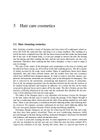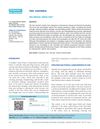TLDR Chemical hair removal can cause skin irritation and other issues, but natural alternatives are being explored.
The document discussed temporary chemical depilation, which used chemicals like thioglycolates to break down hair keratin, facilitating easy hair removal. The depilatory formulas included components such as surface active agents, binders, alkaline pH adjustors, and hair penetrators to enhance efficiency. However, issues such as skin irritation, dark points from remaining hair, and hydrogen disulfide gas formation were noted. Alternatives like papain and eflornithine were mentioned for hair removal, with a focus on finding natural-based substances to reduce hair growth, despite challenges with compound instability in alkaline environments.
 5 citations
,
February 2022 in “Acta Biomaterialia”
5 citations
,
February 2022 in “Acta Biomaterialia” Nanomaterials can improve hair care products and treatments, including hair loss and alopecia, by enhancing stability and safety, and allowing controlled release of compounds, but their safety in cosmetics needs more understanding.
 January 1997 in “Elsevier eBooks”
January 1997 in “Elsevier eBooks” The document explains how shampoos clean, rinses condition, one-step shampoos offer convenience, and hair growth promoters aim to prevent hair loss, emphasizing the importance of scientific evidence for their effectiveness.
 43 citations
,
January 2013 in “Indian Journal of Dermatology, Venereology and Leprology”
43 citations
,
January 2013 in “Indian Journal of Dermatology, Venereology and Leprology” The article concludes that advancements in hair cosmetics require dermatologists to stay informed about products and their potential risks, including allergies and higher risks for hairdressers.
53 citations
,
July 2016 in “Cosmetics” Future hair cosmetics will be safer and more effective.
37 citations
,
October 2015 in “PeerJ” Perming significantly changes hair's molecular structure, while shampoo and conditioner do not.


